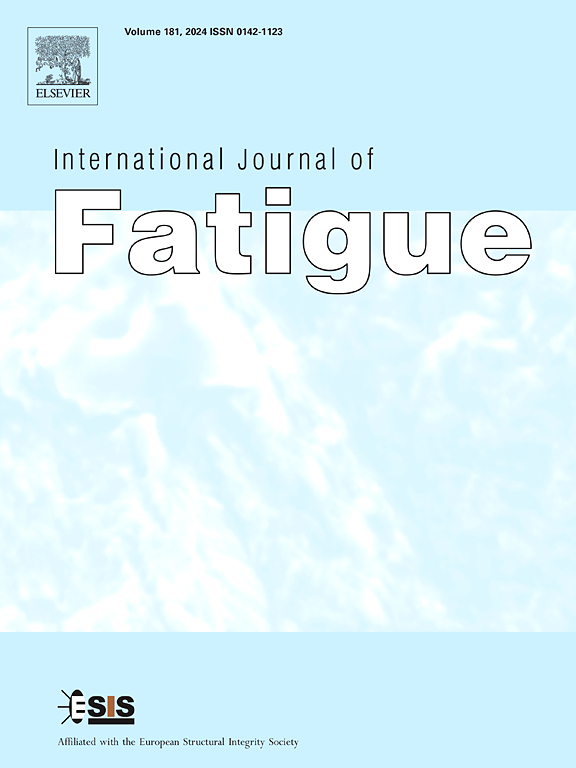考虑循环软化对棘轮行为影响的改进无碳化物贝氏体钢循环塑性模型
IF 6.8
2区 材料科学
Q1 ENGINEERING, MECHANICAL
引用次数: 0
摘要
实验研究了循环软化对无碳化物贝氏体(CFB)钢轨钢棘轮变形的影响。为了准确描述CFB钢的循环软化行为,在运动硬化规则中引入了两个叠加的软化系数,统一描述了瞬态包辛格效应和循环软化。通过结合Ohno的记忆表面,增强了各向同性硬化规则,从而能够更准确地表示棘轮变形过程中与应变幅度相关的循环软化。此外,通过整合基于逻辑函数的棘轮参数,提出了基于Abdel Karim-Ohno模型的修正运动硬化规则,以考虑CFB钢轨钢棘轮行为对附加应力水平的依赖。仿真结果与实验结果的对比表明,该模型能够有效地捕捉循环流化床钢轨在不同加载水平、历史和控制模式下的循环软化和棘轮行为。本文章由计算机程序翻译,如有差异,请以英文原文为准。
An improved cyclic plastic model for carbide-free bainitic steel considering the influence of cyclic softening on ratcheting behavior
The effect of cyclic softening on the ratcheting deformation of carbide-free bainitic (CFB) rail steel is investigated experimentally. To accurately describe the cyclic softening behavior of CFB steel, two superimposed softening coefficients are introduced into the kinematic hardening rule, providing a unified description of the transient Bauschinger effect and cyclic softening. The isotropic hardening rule is enhanced by incorporating Ohno’s memory surface, enabling a more accurate representation of strain amplitude-dependent cyclic softening during ratcheting deformation. Furthermore, a modified kinematic hardening rule based on the Abdel Karim–Ohno model is developed by integrating a logical-function-based ratcheting parameter to account for the additional stress level dependence on the ratcheting behavior of CFB rail steel. The comparison between simulated results and experimental results demonstrates that the proposed model can effectively capture both the cyclic softening and ratcheting behaviors of CFB rail steel under various loading levels, histories, and control modes.
求助全文
通过发布文献求助,成功后即可免费获取论文全文。
去求助
来源期刊

International Journal of Fatigue
工程技术-材料科学:综合
CiteScore
10.70
自引率
21.70%
发文量
619
审稿时长
58 days
期刊介绍:
Typical subjects discussed in International Journal of Fatigue address:
Novel fatigue testing and characterization methods (new kinds of fatigue tests, critical evaluation of existing methods, in situ measurement of fatigue degradation, non-contact field measurements)
Multiaxial fatigue and complex loading effects of materials and structures, exploring state-of-the-art concepts in degradation under cyclic loading
Fatigue in the very high cycle regime, including failure mode transitions from surface to subsurface, effects of surface treatment, processing, and loading conditions
Modeling (including degradation processes and related driving forces, multiscale/multi-resolution methods, computational hierarchical and concurrent methods for coupled component and material responses, novel methods for notch root analysis, fracture mechanics, damage mechanics, crack growth kinetics, life prediction and durability, and prediction of stochastic fatigue behavior reflecting microstructure and service conditions)
Models for early stages of fatigue crack formation and growth that explicitly consider microstructure and relevant materials science aspects
Understanding the influence or manufacturing and processing route on fatigue degradation, and embedding this understanding in more predictive schemes for mitigation and design against fatigue
Prognosis and damage state awareness (including sensors, monitoring, methodology, interactive control, accelerated methods, data interpretation)
Applications of technologies associated with fatigue and their implications for structural integrity and reliability. This includes issues related to design, operation and maintenance, i.e., life cycle engineering
Smart materials and structures that can sense and mitigate fatigue degradation
Fatigue of devices and structures at small scales, including effects of process route and surfaces/interfaces.
 求助内容:
求助内容: 应助结果提醒方式:
应助结果提醒方式:


